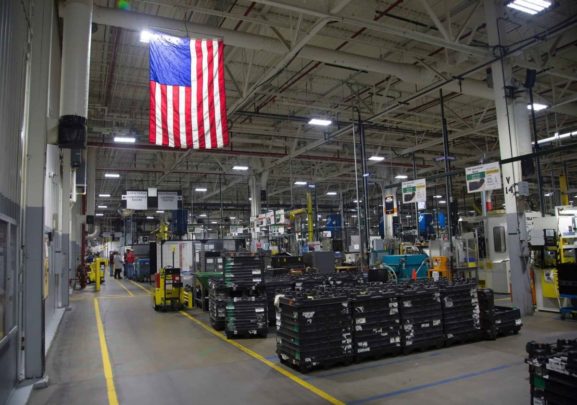3 Steps to Reduce Your Manufacturing Cycle Time
By Adam Grabowski
Director, Global Shop Solutions
 In the high-stakes world of manufacturing, time isn’t just money – it’s everything. Imagine running a race where every second counts and your competition is constantly breathing down your neck. That’s the magic (or madness) of cycle time. It’s the secret ingredient that transforms a sluggish assembly line into a well-oiled machine, churning out products faster than you can say “efficiency.” Whether you’re looking to slash costs, delight customers, or simply keep your warehouse from turning into a storage nightmare, mastering cycle time is like finding the cheat code to the manufacturing game. Buckle up, because we’re about to take a high-speed tour through why this metric matters more than your morning coffee.
In the high-stakes world of manufacturing, time isn’t just money – it’s everything. Imagine running a race where every second counts and your competition is constantly breathing down your neck. That’s the magic (or madness) of cycle time. It’s the secret ingredient that transforms a sluggish assembly line into a well-oiled machine, churning out products faster than you can say “efficiency.” Whether you’re looking to slash costs, delight customers, or simply keep your warehouse from turning into a storage nightmare, mastering cycle time is like finding the cheat code to the manufacturing game. Buckle up, because we’re about to take a high-speed tour through why this metric matters more than your morning coffee.
Lengthy cycle times result from inefficient processes, taking longer to complete jobs and making it more difficult to deliver them on time. They can lead to wasted resources, excessive labor costs, and higher total cost per job, thereby reducing margins and overall profitability of the business.
Conversely, reducing cycle time simplifies processes, improves productivity, and enables faster delivery, thereby generating cost savings, satisfied customers and a competitive edge in your markets. When customers perceive your manufacturing operation as more responsive to demand they are more likely to respond with new and repeat orders – and overall be happier with your business. And who doesn’t want happy customers?
Understanding your production cycle is vital to ensuring that finished goods are produced efficiently, cost-effectively, and safely. It helps identify areas where improvements can and should be made and guides the planning of future production needs. Continuous cycle time reduction lays the foundation for long-term manufacturing success and enables multiple process improvements to work in parallel.
You Can’t Manage What You Don’t Measure
When measured and analyzed correctly, cycle time can provide valuable insights into what you make every day. However, cycle times can vary significantly based on different processes, the quality of machines used to make the product, and the factors included in the cycle measurement. Therefore, achieving accurate readings requires identifying every factor that goes into the measurement.
The cycle time team also needs to confirm whether the measure is tracking a process or unit and indicate whether wait or hold times are included in the calculation. It should also include non-direct labor tasks such as inspecting quality defects and ensuring compliance. You can also calculate how long it takes machines to complete the entire set of operations for one piece (called machine cycle time) or the load and unload time between operations (called effective cycle time).
Ultimately, real-time machine data enables understanding of all the elements of cycle time. Such data immediately generates actionable insights. Changes can be implemented to reduce cycle time as soon as the data appears instead of after the event has run its course. Once you determine the elements to be used during the measurement, calculating the time is relatively straightforward.
Here is the formula used by the best manufacturers:
Cycle time (Ct) = net production time (Pt) divided by number of units produced (Pu) during net production time.
Taking One Step at a Time to Cycle Time Greatness
Implementing cycle counting involves three steps that each contain different activities. Following them in order will keep you on track to shorter cycle times for greater efficiency and profitability.
1. Gather the Data
Cutting cycle times and compressing sequences starts with understanding how your business works. Begin by developing a process map that manually tracks the workflow of a finished product or part. Then calculate a rough estimate cycle time to provide a benchmark to build on. Even if you have to manage the data manually, which can cause equipment effectiveness measurement to skew higher than it should, you need to start with a base level cycle time.
Avoid manual data tracking, when possible, as it is prone to human error, takes a long time, and can disrupt process improvement times. Automating data collection can eliminate the need for manual collection, provide insights that show progress, and identify areas for further improvements.
2. Simplify the Processes
Begin this step by eliminating elements of your production processes that don’t add customer value, such as defects, overproduction, waiting, transportation, motion, over processing, or excess inventory. Then start implementing pull systems, a Lean manufacturing strategy that relies on customer demand to facilitate the production of goods. Instead of having items delivered automatically or by a manager’s order, pull systems prevent overproduction by filling specific item requests from individual customers. This inventory management system produces only what is needed, when, and how much, and reduces waste by producing to meet consumer demand.
The most important activity for step two involves committing to the ongoing practice of making changes and measuring results to maintain and improve your cycle time performance. When you improve a procedure, implement standard work documentation so the process doesn’t vary from the new standard. The document should outline the order of tasks for operators, motions, communication, and other standards to keep the cycle time low and prevent variance.
Audit capacity for every machine to determine if it can handle a large number of complex and time-consuming parts. Then create production schedules that optimize the machine’s capabilities vis-à-vis the customer order. With standard documentation you can consistently identify new opportunities for further reductions in cycle time.
Only after you audit and document your processes can you consistently identify new opportunities for further reduction.
3. Optimize People, Machines, and Design
Now it’s time to organize the shop floor for efficiency. Minimizing the distance between workstations and layouts reduces the time to move items or perform tasks, shortens cycle times, and improves ergonomics, safety, and quality. Set this step into action by moving production cells closer together to improve the flow of value-added operations. Or, connect them with conveyor belts, mobile platforms, shelves, or other solutions.
Balancing your workloads and capacities – the amounts and rates of work your process can handle – can further reduce cycle times by preventing idle time, bottlenecks, and uneven flow. Virtual simulation tools can rearrange computer screens, production lines, power supplies, and other shop floor components without interrupting workflow.
Performing routine machine maintenance is critical for avoiding workflow interruptions. Using analytic tools to streamline tooling changes and set-up times can help minimize their downtime. Automating repetitive tasks relieves the physical burden of manual labor and makes the process faster, steadier and more predictable when calculating cycle times. Automated or robotic equipment can free up skilled workers to exercise their judgment, solve problems, and find new ways to improve processes.
At this point in the cycle time process, optimizing product design reduces unnecessary complexity, enables machinists to make a part or product faster, and can sometimes eliminate a processing step. To achieve the fastest cycle times, engage product developers in working closely with their manufacturing partners to discuss tailoring the design to fit the process and the raw materials.
What are the Benefits of Reducing Cycle Times?
Reducing cycle time provides numerous benefits for your business and your customers. These include:
• Lower Costs. Cycle time reductions lower the cost per unit by making processes faster and more efficient, lowering wait and queue times, automating processes to make labor more efficient, and producing less scrap and rework.
• More Efficient Business Processes. Reducing cycle times builds a culture of improvement by spreading efficiency best practices throughout the organization, motivating companies to make process improvements in all areas of the business.
• Increased Capacity. Faster cycle times increase the effectiveness of your machinery by enabling production of more jobs with the same resources. This facilitates informed capital expenditure decisions based on machine data that reduces cycle time.
• Lower Inventory Costs. Reducing inventory cycle time can lead to lower inventory levels, thereby saving on storage costs, reducing the risk of stock outs, and leading to faster turnover of inventory for improved cash flow.
• Competitive Advantage. Shorter lead times and faster production make your business a “go-to” source for new and existing customers. Lower cycles times enable your team to innovate new products faster and get them to market quicker.
A Cog in Your Cycle Time Reduction Process
The most successful manufacturers shorten cycle times on a continual basis by compressing the time between their production sequences. They accomplish this by making full use of their ERP system’s capabilities. If you examine the different steps in the first two phases of cycle time reduction, it’s easy to see that ERP gives you the data you need to revise and upgrade your processes.
Step three focuses more on relocating machinery and equipment in places that help reduce sequence times. However, automating repetitive tasks with the help of ERP software and third-party integrations can also assist with activities in this step.
Consider this – some ERP users have achieved cycle time reductions of up to 50% by automating processes, analyzing workcenter and individual machine capacities, and scheduling jobs concurrently for maximum efficiency. Cycle time reduction isn’t just a trend; it’s a pillar for long-term growth in manufacturing businesses. It will become mandatory as the manufacturing industry continues to grow more complex and competitive.
ABOUT THE AUTHOR
Adam Grabowski is the Director of Marketing at Global Shop Solutions. He is responsible for translating the company’s business objectives into successful brand, marketing, and communication strategies to drive awareness, revenue, and loyalty.
Learn more about Global Shop Solutions at www.globalshopsolutions.com.



